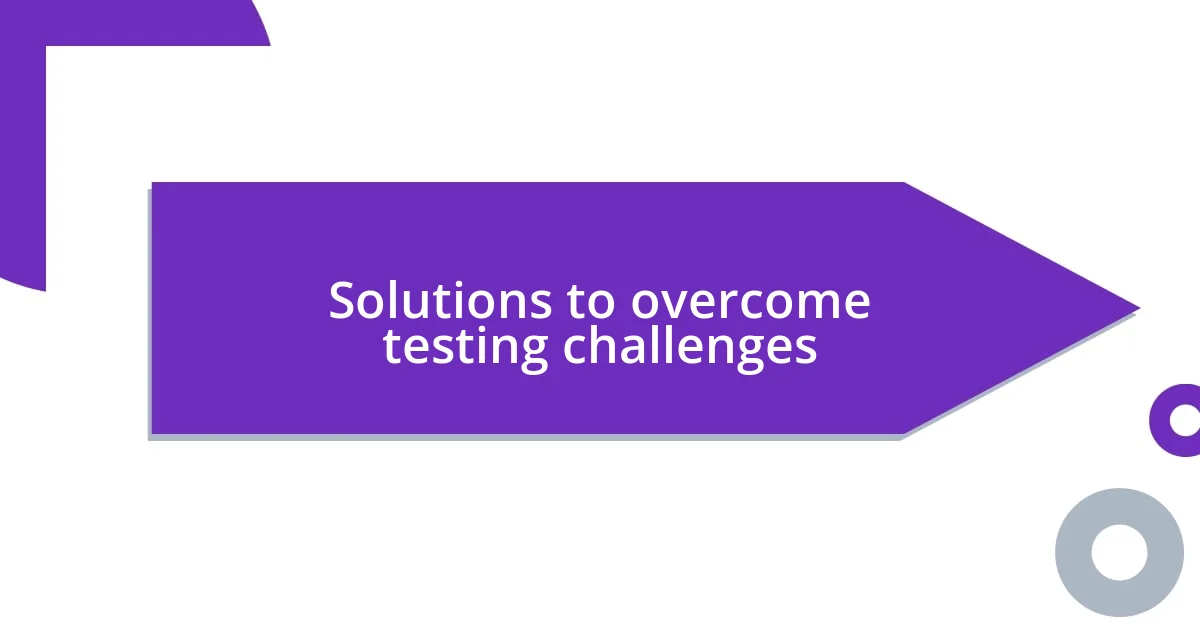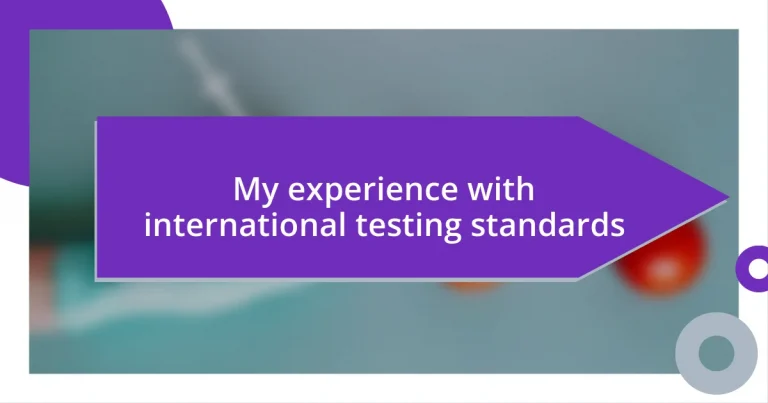Key takeaways:
- Initial anxiety turned to clarity as the author’s team successfully navigated international testing standards, seeing them as a roadmap for product launches.
- Effective communication and a centralized documentation system were pivotal in overcoming testing challenges, fostering collaboration across continents.
- Adhering to international standards not only built consumer trust but also enhanced team synergy, paving the way for future advancements and sustainability in testing practices.

Understanding international testing standards
Understanding international testing standards can initially seem overwhelming. I remember my first encounter with these standards during a project, where I had to ensure compliance with various global protocols. It felt like trying to decode a foreign language! But as I dived deeper, I realized that these standards, like ISO or IEC, are essential because they set a benchmark for quality and safety across borders.
As I navigated these standards, I began to appreciate their role in fostering trust. Have you ever wondered why companies choose to adhere to these guidelines? From my experience, it’s about creating a level playing field in the international market. It ensures that products meet a consistent level of quality, which is reassuring both for businesses and consumers alike.
One thing that struck me was how international testing standards facilitate innovation while safeguarding public interest. I vividly recall a team meeting where we discussed how adhering to these standards sparked new ideas for product improvements. It’s a delicate balance—encouraging creativity while ensuring safety and reliability. How do you think this balance shapes the products you use every day?

Importance of international testing standards
International testing standards play a critical role in ensuring consistency and safety across diverse industries. I can recall a time when I worked on product testing in a multinational company, and one product required compliance with several standards before it could be launched globally. It was a massive relief knowing there was a well-established framework guiding our quality checks; no matter where we distributed our products, consumers would receive them with confidence in their safety and effectiveness.
The benefits of adhering to these standards are clear:
– Consumer Trust: Products are vetted for safety, which reassures customers.
– Market Access: Companies can expand into new regions more easily.
– Reduced Risk: Standardized testing helps identify potential failures early in the development process.
– Innovation Stimulation: Knowing the standards can inspire new approaches to product design and engineering.
– Regulatory Compliance: Adhering to these standards often simplifies meeting local regulations, saving time and resources.
I remember when we received feedback from users praising our commitment to safety and quality, which felt incredibly rewarding. It truly validated the hard work we put into ensuring that our products not only met—but often exceeded—those international standards. This experience reinforced how vital these benchmarks are, not just for businesses like mine, but for the safety and satisfaction of consumers everywhere.

My personal journey with testing
As I reflect on my personal journey with testing, I recall the early days when I felt a mix of anxiety and excitement. I was tasked with leading a project that required us to align our product with international testing standards. Honestly, it felt daunting at first. But as I immersed myself in the details, I discovered a rewarding sense of clarity. The guidelines, once intimidating, became my roadmap, guiding my team toward a successful launch.
I distinctly remember a moment when we passed our compliance tests. Everyone gathered in the conference room, and there was a palpable buzz in the air. It was exhilarating! Achieving those standards wasn’t just about ticking boxes; it was about safeguarding consumers and earning their trust. I knew that every standard met reflected our commitment to quality and safety, and that made all the difference to me and my team.
One specific experience that stands out to me is the feedback we received from a client who emphasized how our adherence to those international standards made their purchasing decisions easier. It was incredibly gratifying to know that our hard work had a positive impact, establishing not just a product but a relationship built on trust. I’ve realized that my journey with international testing standards is not just professional but deeply personal, shaping how I view the market and my responsibility toward consumers.
| Aspect | Experience |
|---|---|
| Initial Reaction | Overwhelmed but excited Felt like decoding a foreign language |
| Key Moment | Pass rate for compliance tests Buzz of success in the conference room |
| Impact Realization | Client feedback on trust Building a relationship over product |

Challenges faced during testing
Navigating the labyrinth of international testing standards can feel like swimming upstream, especially when gaps in communication arise. I remember a particularly challenging project where our team was spread across different continents, and we struggled to align on testing requirements. Misunderstandings were common, and at times, they brought our progress to a grinding halt. Would we have made more rapid advances if we had clearer communication channels? I often pondered that question.
Another daunting challenge was the sheer volume of documentation required to demonstrate compliance. It felt as if we were drowning in paperwork, trying to keep track of every small detail. Some days, I questioned how we could possibly maintain our pace without sacrificing quality. I vividly recall a late night spent ensuring every form was complete and accurate, driven by the looming compliance deadline. It was stressful, but it also galvanized my commitment to thoroughness.
Lastly, variance in standards from one country to another added another layer of complexity. I was often reminded of the time we needed to adapt our product for three different markets, each with its unique testing criteria. It was overwhelming to sort through the conflicting regulations. I found myself asking, how do we ensure we meet these different benchmarks without compromising on innovation? In those moments, I deeply appreciated the expertise of my team, which turned our chaos into a collaborative effort, ultimately enhancing our product’s versatility.

Solutions to overcome testing challenges
When it comes to overcoming testing challenges, effective communication is key. I recall a project where we set up weekly video calls to align on testing requirements. It turned out to be a game-changer. Not only did it reduce misunderstandings, but it also fostered a sense of collaboration that made us feel more like a united team, despite being on different continents. Isn’t it amazing how a simple conversation can bridge gaps and drive progress?
Streamlining documentation can feel like an uphill battle, but I found that implementing a centralized digital platform transformed our approach. Instead of hunting for files across endless emails, we could access everything in one place. I remember one late evening when I realized how much time we saved just by having a shared drive. I found myself thinking, why didn’t we do this sooner? It not only eased my stress but also allowed us to focus more on quality rather than paperwork, which I believe is crucial.
Adapting to different international standards often requires flexibility. I once faced a situation where our product had to meet conflicting requirements from two markets simultaneously. There was a moment of frustration when I thought, how can we possibly keep everyone happy? Then, I asked my team for their insights, and we devised a creative solution that satisfied both sides. It was a powerful reminder that collaboration often sparks innovation, turning a challenging scenario into an opportunity for growth.

Benefits of adhering to standards
Adhering to international testing standards brings a sense of credibility to any project. I remember when our team received positive feedback from clients who valued our compliance with globally recognized benchmarks. It wasn’t just about meeting a requirement; it solidified trust and opened doors for new opportunities. Have you ever felt that moment of pride when your hard work is recognized? I certainly did, and it motivated us to maintain our high standards.
Another immense benefit lies in consistency. By following these standards, we could replicate our testing processes across different projects, which saved us significant time and resources. There was a point when we were handling multiple tests simultaneously, and adhering to a structured approach made it feel manageable. I can’t help but wonder how much chaos would have ensued without those guidelines. It’s almost like having a reliable recipe when baking—you know exactly what to expect.
Ultimately, alignment with international standards paved the way for enhanced collaboration within our diverse team. I distinctly recall a project where we had professionals from various backgrounds working together; those common standards facilitated smoother interactions and a shared understanding of goals. Doesn’t it make teamwork so much more enjoyable when everyone is on the same page? For me, that synergy became the heartbeat of our success, reminding me that shared standards do more than just ensure compliance—they foster unity.

Future of international testing standards
The future of international testing standards seems promising, driven by advancements in technology. I remember the excitement I felt when our team integrated AI tools to streamline the testing process. This shift not only improved accuracy but also allowed us to predict potential issues before they arose. Imagine having the power to foresee challenges—it’s a game changer for any testing environment!
As these standards evolve, there’s an increasing emphasis on sustainability. I once attended a seminar where experts passionately discussed the need for eco-friendly practices in testing procedures. It struck me how critical it is for our industry to adapt to environmental concerns. Isn’t it crucial that we not only focus on efficiency but also on the long-term impact of our work on the planet?
Furthermore, I foresee a tightening collaboration among countries, driven by global challenges that transcend borders. A project I worked on involved different nations pooling their resources to create standards that everyone could trust. How inspiring it was to witness diverse minds collaborating for a meaningful goal! This spirit of unity in standardization could very well define the future landscape, pushing us toward more cohesive and harmonized testing practices globally.














